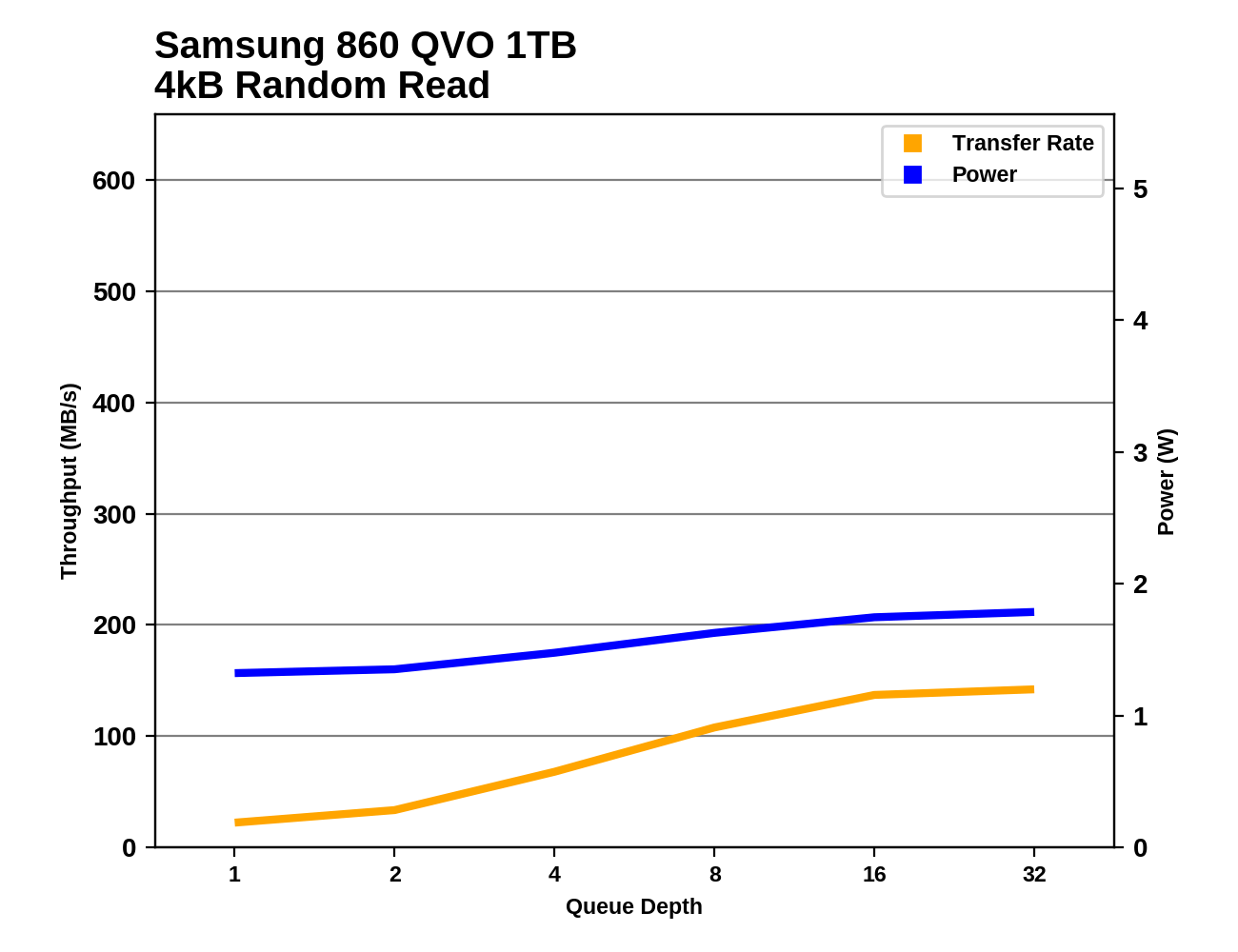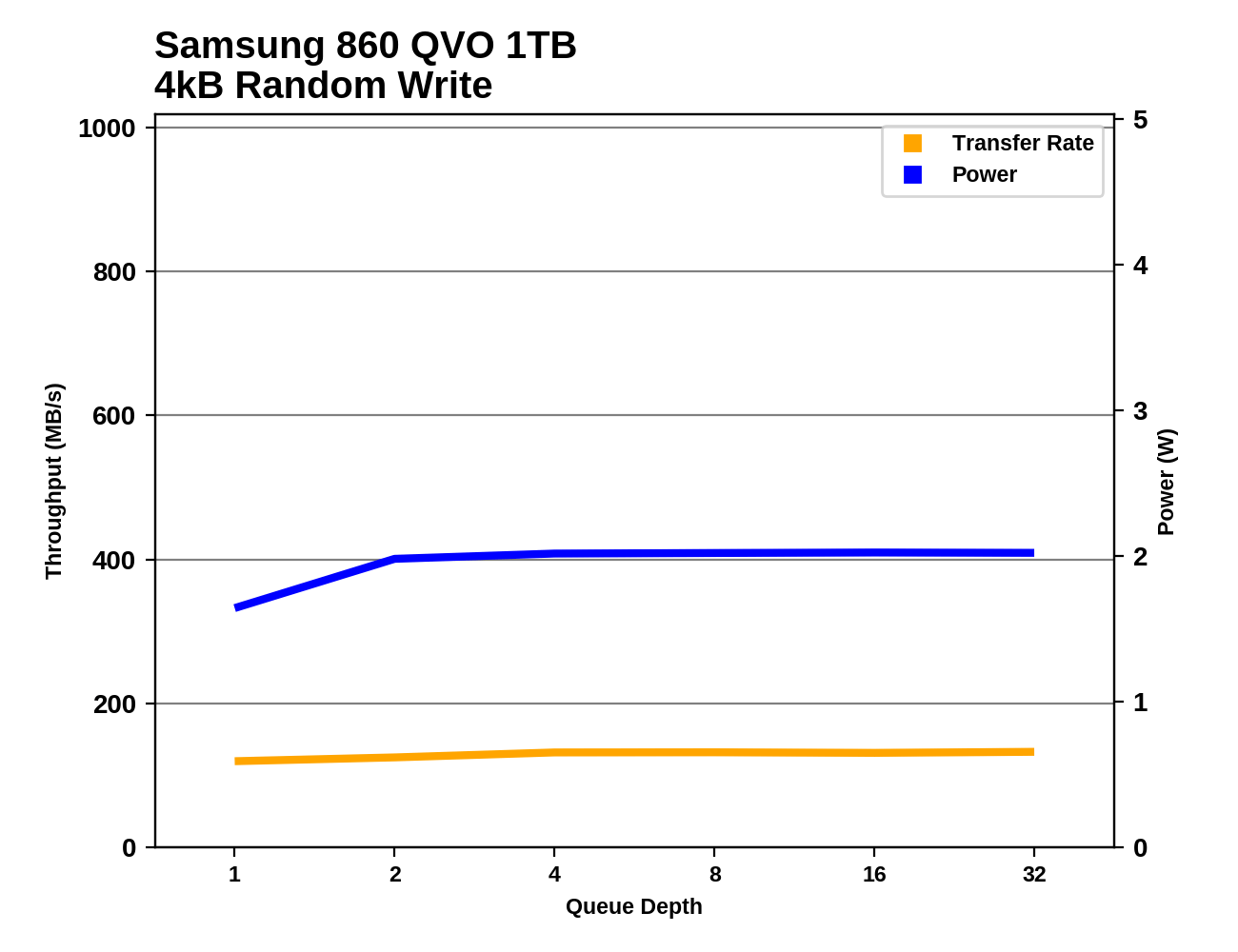The Samsung 860 QVO (1TB, 4TB) SSD Review: First Consumer SATA QLC
by Billy Tallis on November 27, 2018 11:20 AM ESTRandom Read Performance
Our first test of random read performance uses very short bursts of operations issued one at a time with no queuing. The drives are given enough idle time between bursts to yield an overall duty cycle of 20%, so thermal throttling is impossible. Each burst consists of a total of 32MB of 4kB random reads, from a 16GB span of the disk. The total data read is 1GB.

The burst random read performance of the Samsung 860 QVO is clearly lower than the 3D TLC competition, while the Intel/Micron QLC NVMe drives have no trouble competing against the field of mainstream SATA TLC drives. Even in the worst case of the smallest QVO being entirely full, read speeds are still vastly better than a hard drive.
Our sustained random read performance is similar to the random read test from our 2015 test suite: queue depths from 1 to 32 are tested, and the average performance and power efficiency across QD1, QD2 and QD4 are reported as the primary scores. Each queue depth is tested for one minute or 32GB of data transferred, whichever is shorter. After each queue depth is tested, the drive is given up to one minute to cool off so that the higher queue depths are unlikely to be affected by accumulated heat build-up. The individual read operations are again 4kB, and cover a 64GB span of the drive.

On the longer random read test, the Toshiba TR200 DRAMless TLC drive is no longer able to stay ahead of the 860 QVO, and even the Intel/Micron QLC drives fall behind most mainstream SATA drives (especially when full).
 |
|||||||||
| Power Efficiency in MB/s/W | Average Power in W | ||||||||
The power consumption of the 860 QVO during the random read test is only slightly higher than its TLC-based relatives, but that's plenty to push its efficiency scores into last place, given the poor performance.
 |
|||||||||
The queue depth scaling of the 860 QVO during random reads is fairly typical in shape, with improvements starting to taper off after QD16. However, the vertical scale is important: the QVO doesn't ever reach even half the performance of the best TLC-based SATA SSDs.
Looking at the 1TB 860 QVO's random read results compared to all the other SATA drives in the benchmark database, it is clear that the QVO isn't anywhere near the cutting edge for power efficiency or peak performance, but there are worse drives out there.
Random Write Performance
Our test of random write burst performance is structured similarly to the random read burst test, but each burst is only 4MB and the total test length is 128MB. The 4kB random write operations are distributed over a 16GB span of the drive, and the operations are issued one at a time with no queuing.

The SLC cache of the 860 QVO is very effective for the burst random write test, leaving it tied or slightly ahead of the 860 EVO.
As with the sustained random read test, our sustained 4kB random write test runs for up to one minute or 32GB per queue depth, covering a 64GB span of the drive and giving the drive up to 1 minute of idle time between queue depths to allow for write caches to be flushed and for the drive to cool down.

On the longer random write test, the larger SLC cache and greater parallelism of the 4TB 860 QVO helps it keep pace with other top SATA SSDs, but the 1TB QVO has to settle for being slightly faster than the DRAMless TLC drive.
 |
|||||||||
| Power Efficiency in MB/s/W | Average Power in W | ||||||||
The QVO is again a bit more power hungry than most of the TLC drives, which doesn't hurt the 4TB QVO's efficiency score much thanks to its good performance, but the 1TB QVO ends up tied for last place with the full-drive performance from the Intel/Micron QLC drives.
 |
|||||||||
The 1TB 860 QVO shows very little random write performance scaling with increasing queue depth, though power consumption does go up significantly from QD1 to QD2. The 4TB 860 QVO shows a much more typical scaling up to saturation at QD4, with a performance curve that is almost an exact match for the 4TB 860 EVO.
There are some TLC SATA SSDs that draw the same power to deliver half the random write performance of the 1TB 860 QVO, but in the grand scheme of things the 1TB QVO's results on this test are sub-par. The 4TB starts out in the same spot but ends up hitting the SATA performance wall without consuming too much power.












109 Comments
View All Comments
Santoval - Wednesday, November 28, 2018 - link
"Right now there is exactly zero reason to choose it over the EVO. The 500GB EVO costs about $130 US where I'm from, there's very little incentive for me to buy it given the "inflated" price."Assuming the 500GB EVO actually costs as much as the 1TB EVO in your country (I'm frankly skeptical about this, but let's take you at your word) what makes you thing that the 1TB QVO will not in turn cost as much as the 2TB QVO?
Are you seriously suggesting that your country's taxmen or tariffmen are going to place much lower taxes/tariffs on QLC based SSDs than one TLC based SSDs?
Lolimaster - Thursday, November 29, 2018 - link
Import the 1TB from Amazon, you can do that to any south american country.Impulses - Thursday, November 29, 2018 - link
Even at 25% cheaper than an EVO it would barely beat the (current) best sale price of other mainstream TLC SSD... And TLC is probably not going away any time soon. I'd love to see the price gap reach 25%+ sooner rather than later tho.Oxford Guy - Tuesday, November 27, 2018 - link
It may be that companies are hoping for higher margin. It is not impossible for that to happen. CDs, for example, were a higher margin product than the LPs they replaced.If supply of TLC shrinks, as companies move to QLC production, the competition between TLC and QLC also shrinks, making room, potentially, for more margin.
Amandtec - Tuesday, November 27, 2018 - link
The yields are poor at the moment so there is no point selling them low. It has a big effect on your share price if you release new game changing technology like QLC to market, because shareholders are sophisticated and understand the long term term strategy here.moozooh - Wednesday, November 28, 2018 - link
> The yields are poor at the moment so there is no point selling them low.I think you misunderstand: there's no point *buying them high*. The only point of these drives is buying them low. So not selling them low means *not selling them*, period.
Customers may not be shareholders, but they aren't idiots, either. They understand QLC is a step down in almost every aspect of the drive's operation. It's an inferior product, and the price needs to reflect that for it to be considered for purchase.
jjj - Wednesday, November 28, 2018 - link
Actually , R&D is surprisingly low compared to the revenue generated and, aside from that, they might be close enough to 5 cents per GB production costs now for QLC so if there is a global economic crash caused by Trump and his tariffs, we could see 50$ per TB in half a year from now.Otherwise, could be 2020-2021 for that kind of price, especially if China manages to ramp output.
NAND prices are down a bit from peak but folks still have 40-50% overall NAND margins,there is room for much lower prices and production costs decline 15-25% per year.
R0H1T - Wednesday, November 28, 2018 - link
>they might be close enough to 5 cents per GB production costs now for QLCSure but that's at least 6~12 months away from now. So how can anyone realistically expect Samsung to debut the QVO at such prices given there's no competition (SATA QLC) nor any reason for Samsung to not make hay while the sun shines? For anyone who says the $130 US for 1TB EVO is the normal price, it's not in the ROTW.
sonny73n - Wednesday, November 28, 2018 - link
“Yeah no one's selling you 8TB for $400 anytime soon. Aside from the fact that the R&D costs for QLC need to be recuperated first & companies need to reinvest an increasing amount for future development, there's also a point after which it doesn't make sense for the SSD, or NAND, maker to sell these at a loss.If you really want something that big, for dirt cheap, try spinners instead.”
You sound like a Samsung shill. If HDD manufacturers decide to keep on R&D for those spinners, are you willing to pay extra for their future development? Beside, SSD tech has been around for a decade, now it costs less to make an SSD than to make an HDD for the same capacity.
R0H1T - Wednesday, November 28, 2018 - link
>You sound like a Samsung shill.Oh sure let's all forget the aftermath of the Thai floods ~ insane prices, insane quality (as in really bad) w/warranties as low as just a year long! So while the HDD makers sat on their collective behind, much like Intel, the SSD makers out paced them, out innovated(?) them & could make spinners virtually obsolete, except bottom of the barrel 5400/5900 rpm drives especially in $/GB.
So let's see, arguing for higher prices because R&D is an ever increasing (one time) cost that needs to be recuperated, is shilling now? Do you also want me to feel sad because vacuum tubes are dead or that NAND prices will continue to fall, in the foreseeable future?